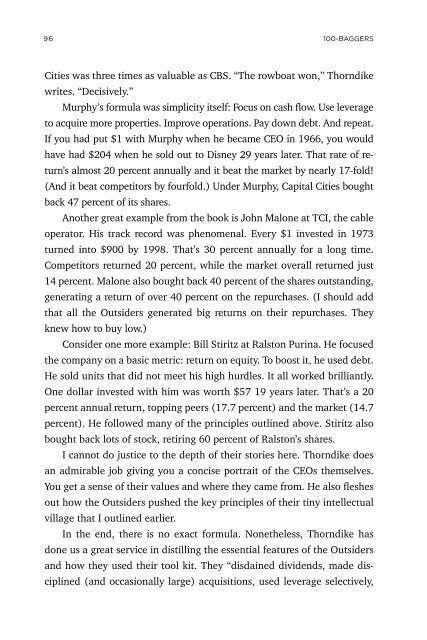Create successful ePaper yourself
Turn your PDF publications into a flip-book with our unique Google optimized e-Paper software.
96<br />
100-BAGGERS<br />
Cities was three times as valuable as CBS. “The rowboat won,” Thorndike<br />
writes. “Decisively.”<br />
Murphy’s formula was simplicity itself: Focus on cash flow. Use leverage<br />
to acquire more properties. Improve operations. Pay down debt. And repeat.<br />
If you had put $1 with Murphy when he became CEO in 1966, you would<br />
have had $204 when he sold out to Disney 29 years later. That rate of return’s<br />
almost 20 percent annually and it beat the market by nearly 17-fold!<br />
(And it beat competitors by fourfold.) Under Murphy, Capital Cities bought<br />
back 47 percent of its shares.<br />
Another great example from the book is John Malone at TCI, the cable<br />
operator. His track record was phenomenal. Every $1 invested in 1973<br />
turned into $900 by 1998. That’s 30 percent annually for a long time.<br />
Competitors returned 20 percent, while the market overall returned just<br />
14 percent. Malone also bought back 40 percent of the shares outstanding,<br />
generating a return of over 40 percent on the repurchases. (I should add<br />
that all the Outsiders generated big returns on their repurchases. They<br />
knew how to buy low.)<br />
Consider one more example: Bill Stiritz at Ralston Purina. He focused<br />
the company on a basic metric: return on equity. To boost it, he used debt.<br />
He sold units that did not meet his high hurdles. It all worked brilliantly.<br />
One dollar invested with him was worth $57 19 years later. That’s a 20<br />
percent annual return, topping peers (17.7 percent) and the market (14.7<br />
percent). He followed many of the principles outlined above. Stiritz also<br />
bought back lots of stock, retiring 60 percent of Ralston’s shares.<br />
I cannot do justice to the depth of their stories here. Thorndike does<br />
an admirable job giving you a concise portrait of the CEOs themselves.<br />
You get a sense of their values and where they came from. He also fleshes<br />
out how the Outsiders pushed the key principles of their tiny intellectual<br />
village that I outlined earlier.<br />
In the end, there is no exact formula. Nonetheless, Thorndike has<br />
done us a great service in distilling the essential features of the Outsiders<br />
and how they used their tool kit. They “disdained dividends, made disciplined<br />
(and occasionally large) acquisitions, used leverage selectively,


